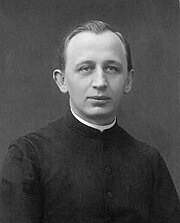Joseph Wittig's Human Design Chart
1/3 Self Projected Projector**Joseph Wittig: A Human Design Perspective**
Joseph Wittig (22 January 1879 – 22 August 1949) was a notable German theologian and writer, renowned for his role as a religious reformer in Breslau. His work often challenged the established doctrines of the Catholic Church, a reflection of his unique Human Design as a Projector. With a Self-Projected Inner Authority, Wittig possessed a natural ability to guide others through his insights, though he needed to wait for invitations to share his profound ideas.
Wittig’s theological and literary contributions frequently placed him at odds with the Church hierarchy. In 1922, he authored “Die Erlösten” (The Redeemed), an article critically examining church dogma. His 1925 publication, “Leben Jesu in Palästina, Schlesien und anderswo,” which offered a historical reconstruction of Jesus Christ’s life, was deemed controversial and subsequently placed on the Church’s index of banned books. This boldness aligns with his 1/3 Profile, characterized by a foundational need for experimentation and learning through trial and error.
In 1926, Wittig faced excommunication from the Church, leading to his resignation from his teaching position at Breslau. This period of disconnection from institutional authority allowed him to embrace his role as a private scholar and writer in Neusorge. Here, he authored numerous popular stories and religious-themed works, channeling his creative energy through the 13-33 channel, which signifies the ability to communicate deeply and connect through shared experiences.
Wittig’s journey took a significant turn when he collaborated with philosopher Martin Buber and physiologist Viktor von Weizsäcker as co-editor of the magazine “Die Kreatur,” founded by Hans Ehrenberg and Eugen Rosenstock-Huessy. His work during this time reflected his Right Angle Cross of The Unexpected (41/31 | 28/27), indicating a life path filled with surprises and transformative experiences.
After years of estrangement, Wittig was officially reconciled with the Church hierarchy in 1946. He continued to influence others through his writings until his passing on 22 August 1949. His legacy as a thinker and reformer remains significant, offering insights into the interplay between faith, authority, and personal expression within the framework of Human Design.
Discover More Famous People
Browse and analyze over 55,000 public figures and celebrities.
Ra Uru Hu
5/1 Manifestor
Martha Stewart
4/6 Manifestor
David Lynch
4/6 Generator
Barack Obama
6/2 Projector
Steve Jobs
6/3 Generator
Vladimir Putin
5/1 Manifestor
Kim Kardashian
3/5 Generator
Michael Jackson
1/3 Projector
Marilyn Monroe
6/2 Projector
Ariana Grande
2/4 Projector
Oprah Winfrey
2/4 Generator
Johnny Depp
2/4 ManifestorWhat is HumanDesign.ai and how does it work?
Curious what makes Joseph Wittig tick? HumanDesign.ai instantly maps their exact birth data into a fully interactive clickable bodygraph chart, letting you hover or tap every center, channel, and gate for plain-language explanations. Bella, the platform’s built-in AI guide, adds context in real time, translating complex mechanics into everyday insights so you can see how Joseph Wittig’s strengths, challenges, and life themes play out on-screen.
The same tools are waiting for you. Generate your own Human Design Chart in seconds, open a library of 2000+ suggested questions, and chat with Bella as often as you like to decode your design, daily transits, and even relationship dynamics.
Want to compare energies? Save unlimited charts for friends, family, or clients, then ask Bella to reveal compatibilities, composite patterns, or coaching tips, all in one conversation thread.
Start free with core features, or unlock our Personal and Pro plans for deeper dives: unlimited Q&A, celebrity chart search spanning 55,000+ public figures, white-label PDF reports, branded content generation, and a professional profile with built-in booking for practitioners. Whether you’re exploring your own potential or guiding others, HumanDesign.ai delivers an ever-expanding toolbox of AI-powered insights—no spreadsheets, no jargon, just clarity at your fingertips.
Ready to see yours? Signup for FREE today!

